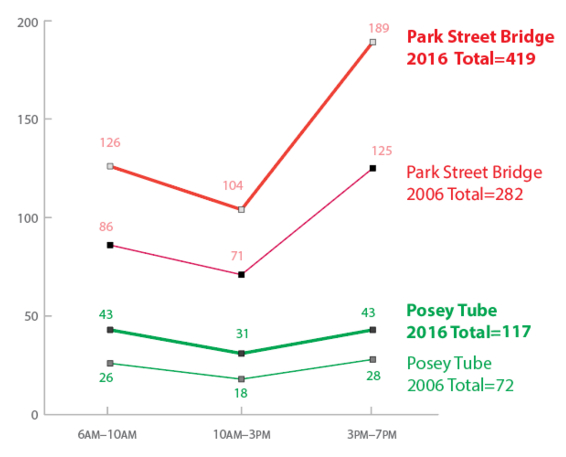There's been a nearly 70 percent increase in cyclists traveling the Park Street Bridge over the past ten years, according to a recently completed study conducted by the advocacy group Bike Walk Alameda. That fact is just one of many from the study that shows the increasing demand for improved bicycle infrastructure on Alameda Island--most notably for a bicycle and pedestrian estuary bridge connecting to Jack London Square. Currently, the only route for cyclists and pedestrians from western Alameda to Jack London Square and Oakland is the narrow, dangerous, and downright oppressive walkway in the Posey car tube. From the study:
Bike Walk Alameda recently conducted counts of bicyclists and pedestrians traveling between Alameda and Oakland at two separate locations. Having done the very same audit in the fall of 2006, these counts offer interesting insights into how biking and walking patterns have changed in these locations over the last ten years. The numbers underscore the original finding that the Tube is an impediment to potential bicycle and pedestrian trips, only more significantly than anticipated. They highlight the need for an alternative estuary crossing on Alameda’s West End. This would enable substantially more people to bike or walk, in turn reducing automobile traffic through the Posey and Webster Tubes and surrounding areas.
Streetsblog readers will recall that last November volunteers from Bike Walk Alameda took shifts sitting outside the mouth of the Posey Tube and the landing of the Park Street bridge, where they counted passing cyclists and pedestrians. Streetsblog also rode through the Posey tube, just to get an idea of how awful it is--the data collected by Bike Walk strongly reinforces the notion that the horrible environment of the Posey Tube is significantly constraining the number of people who would ride from Western Alameda to West Oakland and other nearby BART stations, or directly to jobs in downtown Oakland.
BART trains are audible from Western Alameda, but getting to them by bike without using the tube requires either riding miles away to the Park Street Bridge, which some people do, or loading the bike onto a bus. "The Posey Tube remains extremely unattractive to bicyclists and pedestrians, even with the recent upgrades completed by Caltrans in summer 2016," concludes the study.
Meanwhile, new housing and retail developments are coming online in Western Alameda, but the only transportation planning seems to be more of the same: huge roads and "Level of Service" style intersections. An estuary bridge, which is roughly estimated to cost $60 million, would be a simple way to make BART accessible to Western Alameda, but somehow this obvious solution isn't yet getting traction. As written in the study's conclusions: "With nearly 2,000 housing units approved, completed or under construction in Alameda alone, much of it concentrated in Alameda’s West End, congestion through and around the Tubes will continue to grow in the very near future, as will pressure for a better alternative for bicyclists and pedestrians."
Unfortunately, push back from the Coast Guard--which has objected to past efforts to build a bridge across the estuary--and money issues have delayed the construction of a bridge for years. But these advocates will keep gathering data and making the case that its pennies on the dollar, when one considers the cost of increased car traffic and stranding cyclists and pedestrians a stone's throw from BART and downtown Oakland.






